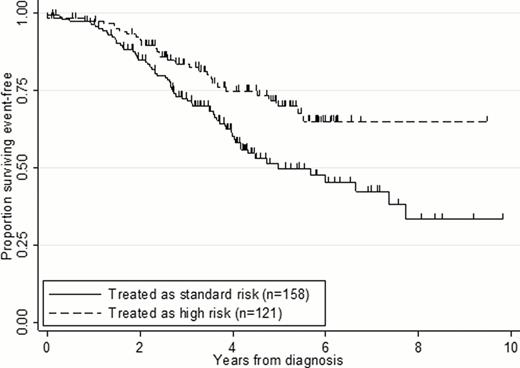Abstract
Intrachromosomal amplification of chromosome 21 (iAMP21) is a distinct cytogenetic subgroup of childhood BCP-ALL, characterised by older age, low white cell count (WCC) and poor outcome on standard therapy. It is identified by a complex structure of one copy of chromosome 21, highly variable between patients, with a common 5.1Mb region of amplification within which the RUNX1 gene is located. Thus FISH, using probes directed to RUNX1 provides a reliable detection method, defining iAMP21 as ≥5 copies of RUNX1 ≥4 on the abnormal chromosome 21. The Ponte di Legno International Childhood ALL Workshop has collected data from 513 iAMP21 patients from 15 international study groups in order to further characterise this subgroup and improve identification.
iAMP21 was mutually exclusive of ETV6-RUNX1 fusion (509 tested), MLL rearrangement (391 tested), TCF3-PBX1/TCF3-HLF (151 tested). There was evidence of classical high hyperdiploidy in two of the 428 patients with a successful cytogenetic result. Four patients (393 tested) were positive for the BCR-ABL1 fusion. In addition to iAMP21 all patients had one normal chromosome 21, apart from 10 patients with two copies of normal 21 in addition to iAMP21, and 4 patients with an additional iAMP21. Other whole chromosomes commonly gained or lost among the 398 patients with abnormal karyotypes were: +X (21%, n=85), −7 (5%, n=19), +10 (4%, n=17), +14 (4%, n=17), and −15 (3%, n=11). Abnormalities of 11q (14%, n=57), 7q (9%, n=35), 9p (9%, n=36) and 12p (6%, n=24) were the most frequent visible chromosomal imbalances. Deletions of CDKN2A/B and ETV6 occurred in 16% and 34% cases, respectively, suggesting that these genes were the targets of 9p and 12p abnormalities. The incidences of deletions of ETV6 (34% vs 22%) and RB1 (40% vs 6%), as well the CRLF2 rearrangement, P2RY8-CRLF2 (19% vs 4%), were significantly higher among the iAMP21 patients than a comparator cohort of 1427 children with BCP-ALL. There were a number of patients with constitutional abnormalities involving chromosome 21: Down syndrome (n=1), ring chromosome 21, r(21)c (n=3) and Robertsonian translocation between chromosomes 15 and 21, rob(15;21)(q10;q10)c (n=4). It was intriguing that in the one case with r(21)c and those with rob(15;21)(q10;q10)c, in which an acquired abnormal karyotype was present, it was the chromosome with the constitutional abnormality which gave rise to the abnormal iAMP21 chromosome.
In terms of the demographic profile of iAMP21 patients, 52% were female and 48% were male, median age was 9 years (range 2–23). Patients <10 and ≥10 years old were equally distributed (51% vs 49%). The median WCC was 5×109/L, range (<1–900×109/L), with only 3% having a high WCC >50 x109/L (n=13). The NCI Risk status was standard risk (SR) in 48% and high risk (HR) in 52%. Follow-up data were available for 283 patients diagnosed before 01/01/2009. Complete remission (CR) was achieved in 280/283 (99%) of which 90 (32%) suffered a relapse and 47 (17%) patients died. In total 43% were treated as HR, with the remainder (57%) treated as SR. There was a significant improvement in event free survival (EFS) (Figure) for patients treated as HR compared to SR. After a median follow-up time of 3.4 years, the 5 year EFS rates were 70% (95% CI 59–78) and 50% (30–59), respectively, hazard ratio 0.73 (95% CI 0.59–0.91) (p=0.005).
Patients with iAMP21 display a unique spectrum of genetic abnormalities, which may be useful for improving identification of iAMP21: gain of chromosomes X, 10 or 14 in the absence of high hyperdiploidy, or monosomy 7/deletion of 7q, deletions of 11q, including MLL and ATM genes, P2RY8-CRLF2, deletions of ETV6 and RB1. These characteristic abnormalities provide useful data to ascertain the presence of iAMP21 when no metaphases are available to visualise the abnormal chromosome 21, or in the rare cases where the abnormal chromosome 21 has atypical rearrangements with other chromosomes. In rare cases, iAMP21 is associated with BCR-ABL1 and high hyperdiploidy, but is exclusive of other chromosomal abnormalities of prognostic significance. Although Down syndrome was rare, other constitutional abnormalities of chromosome 21 may be related to iAMP21 in these patients. Accurate identification of this abnormality is important due to the treatment implications. This study has shown that treatment of iAMP21 patients as HR provides a significant improvement in outcome.
EFS for iAMP21 patients treated as HR and SR
No relevant conflicts of interest to declare.

This icon denotes a clinically relevant abstract
Author notes
Asterisk with author names denotes non-ASH members.


This feature is available to Subscribers Only
Sign In or Create an Account Close Modal